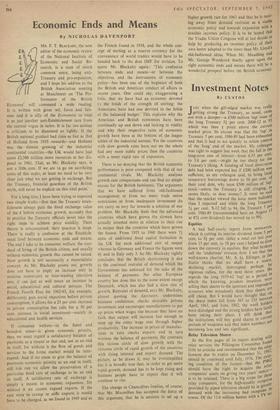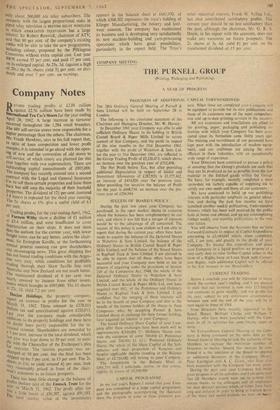Investment Notes
By CUSTOS
JUST when the gilt-edged market was really getting strong the Treasury, as usual, came out with a damper—a £500 million lap' issue of the long Treasury 51 per cent. 2008-12 at 95 which was then I point above the current market price. Its excuse was that the 'tap' in Treasury 5 per cent. 1986-89 had been exhausted and that it had to act quickly to retain control of the 'long' end of the market. My colleague was right to suggest last week that the fall in the long-term rate of interest—from 6.35 per cent. to 5.8 per cent.—might be too sharp for the Treasury's liking. A funding of local short-term debt had been expected but if £200 million was sufficient, as my colleague said, to bring local temporary borrowings down to 16 per cent. (3.! their total debt, why issue £500 million of 'tap stock—unless the Treasury is still clinging, as seems likely, to dear money? It must be said that the market viewed the issue more bullishlY. than I expected and while the long Treasury 5f per cent. '8-12 fell to 94, the Treasury 5 per cent. 1986-89 (recommended here on August 17 at 87„- cum dividend) has moved up to 90,1.
Equities
A bad half-yearly report from MONSANTO, which is cutting its interim dividend from 5 per cent. to 31 per cent. (after a total cut last year from 15 per cent. to 10 per cent.) helped to slow down the recovery in equities. But what brokers call the 'undertone' remains firm. I see that the well-known chartist, Mr. A. G. Ellinger, in the Statist thinks that we shall have a weary, declining market, interrupted perhaps he vigorous rallies, for the next three years. Fl regards the long 1959-62 'top' as a period in which the knowing, prudent investors were selling their shares to the ignorant and imprudent investors who mistakenly think that shares ate still cheap. But I would have thought that on the sharp index fall from 365 to 253 betwee° April, 1961, and June, 1962, the weak
holders
were dislodged and the strong holders have lately been taking their place. 1 still think that the institutions will buy good shares in current periods of weakness and that index numbers are becoming less and less significant.
Relay Television Shares
In the five pages of its report dealing with, relay services the Pilkington Committee found little to criticise and recommended that the relay licences due to expire on December 31, 196.. should be continued until July, 1976. The exist- ing condition of the licence—that the PI", should have the right to acquire the relay companies' assets on giving two years' notice; is to be retained. There is a big scope for these relay companies, for the high-quality rccePtiter provided by piped television should be in greater demand with the increasing bad reception towns. Of the 11.6 million homes with a TV set Only about 500,000 are relay subscribers. The company with the largest proportional stake in Piped relay television is BRITISH RELAY WIRELESS trl which ASSOCIATED TELEVISION has a large interest. Sir Robert Renwick, chairman of ATV, said that 80 per cent. of the company's existing cables will be able to take the new programmes, including colour, proposed by the Pilkington Committee without extra capital cost. Last year RIM earned 35 per cent. and paid 17 per cent. on its enlarged capital. At 23s. 3d. (against a high of 28s.) the 5s. shares yield 31 per cent. on divi- dends and over 7 per cent. on earnings.



































 Previous page
Previous page